Related Research Articles

Amplitude modulation (AM) is a modulation technique used in electronic communication, most commonly for transmitting messages with a radio wave. In amplitude modulation, the amplitude of the wave is varied in proportion to that of the message signal, such as an audio signal. This technique contrasts with angle modulation, in which either the frequency of the carrier wave is varied, as in frequency modulation, or its phase, as in phase modulation.

Analog television is the original television technology that uses analog signals to transmit video and audio. In an analog television broadcast, the brightness, colors and sound are represented by amplitude, phase and frequency of an analog signal.

Frequency modulation (FM) is the encoding of information in a carrier wave by varying the instantaneous frequency of the wave. The technology is used in telecommunications, radio broadcasting, signal processing, and computing.
In electronics and telecommunications, modulation is the process of varying one or more properties of a periodic waveform, called the carrier signal, with a separate signal called the modulation signal that typically contains information to be transmitted. For example, the modulation signal might be an audio signal representing sound from a microphone, a video signal representing moving images from a video camera, or a digital signal representing a sequence of binary digits, a bitstream from a computer.
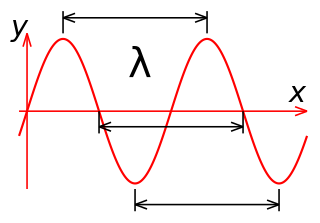
In physics and mathematics, wavelength or spatial period of a wave or periodic function is the distance over which the wave's shape repeats. In other words, it is the distance between consecutive corresponding points of the same phase on the wave, such as two adjacent crests, troughs, or zero crossings. Wavelength is a characteristic of both traveling waves and standing waves, as well as other spatial wave patterns. The inverse of the wavelength is called the spatial frequency. Wavelength is commonly designated by the Greek letter lambda (λ). The term "wavelength" is also sometimes applied to modulated waves, and to the sinusoidal envelopes of modulated waves or waves formed by interference of several sinusoids.

John Logie Baird was a Scottish inventor, electrical engineer, and innovator who demonstrated the world's first live working television system on 26 January 1926. He went on to invent the first publicly demonstrated colour television system and the first viable purely electronic colour television picture tube.
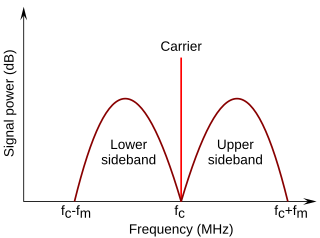
In radio communications, a sideband is a band of frequencies higher than or lower than the carrier frequency, that are the result of the modulation process. The sidebands carry the information transmitted by the radio signal. The sidebands comprise all the spectral components of the modulated signal except the carrier. The signal components above the carrier frequency constitute the upper sideband (USB), and those below the carrier frequency constitute the lower sideband (LSB). All forms of modulation produce sidebands.
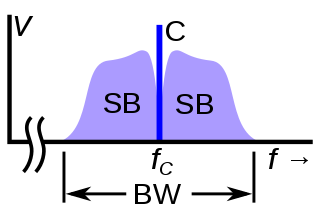
In telecommunications, a carrier wave, carrier signal, or just carrier, is a periodic waveform that carries no information that has one or more of its properties modified by an information-bearing signal for the purpose of conveying information.
Mode locking is a technique in optics by which a laser can be made to produce pulses of light of extremely short duration, on the order of picoseconds (10−12 s) or femtoseconds (10−15 s). A laser operated in this way is sometimes referred to as a femtosecond laser, for example, in modern refractive surgery. The basis of the technique is to induce a fixed phase relationship between the longitudinal modes of the laser's resonant cavity. Constructive interference between these modes can cause the laser light to be produced as a train of pulses. The laser is then said to be "phase-locked" or "mode-locked".
A transducer is a device that converts energy from one form to another. Usually a transducer converts a signal in one form of energy to a signal in another. Transducers are often employed at the boundaries of automation, measurement, and control systems, where electrical signals are converted to and from other physical quantities. The process of converting one form of energy to another is known as transduction.
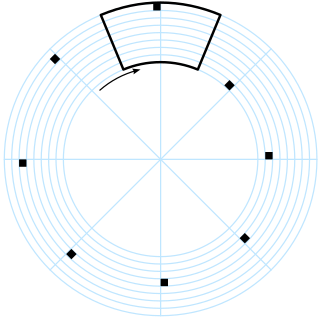
A Nipkow disk, also known as scanning disk, is a mechanical, rotating, geometrically operating image scanning device, patented by Paul Gottlieb Nipkow in Berlin. This scanning disk was a fundamental component in mechanical television, and thus the first televisions, through the 1920s and 1930s.
Video modulation is a strategy of transmitting video signal in the field of radio modulation and television technology. This strategy enables the video signal to be transmitted more efficiently through long distances. In general, video modulation means that a higher frequency carrier wave is modified according to the original video signal. In this way, carrier wave contains the information in the video signal. Then, the carrier will "carry" the information in the form of radio frequency (RF) signal. When carrier reaches its destination, the video signal is extracted from the carrier by decoding. In other words, the video signal is first combined with a higher frequency carrier wave so that carrier wave contains the information in video signal. The combined signal is called radio-frequency signal. At the end of this transmitting system, the RF signals stream from a light sensor and hence, the receivers can obtain the initial data in the original video signal.

Continuous-wave radar is a type of radar system where a known stable frequency continuous wave radio energy is transmitted and then received from any reflecting objects. Individual objects can be detected using the Doppler effect, which causes the received signal to have a different frequency from the transmitted signal, allowing it to be detected by filtering out the transmitted frequency.

Mechanical television or mechanical scan television is an obsolete television system that relies on a mechanical scanning device, such as a rotating disk with holes in it or a rotating mirror drum, to scan the scene and generate the video signal, and a similar mechanical device at the receiver to display the picture. This contrasts with vacuum tube electronic television technology, using electron beam scanning methods, for example in cathode-ray tube (CRT) televisions. Subsequently, modern solid-state liquid-crystal displays (LCD) and LED displays are now used to create and display television pictures.
The Jeffree cell was an early acousto-optic modulator, best known for its use in the Scophony system of mechanical television. It was invented by J.H. Jeffree in 1934, and was a major improvement over the Kerr cell modulators used up to that time by allowing more than 200 times the available modulated light.
A photoelastic modulator (PEM) is an optical device used to modulate the polarization of a light source. The photoelastic effect is used to change the birefringence of the optical element in the photoelastic modulator.

Stooky Bill was the name given to the head of a ventriloquist's dummy that Scottish television pioneer John Logie Baird used in his 1924 experiments to transmit a televised image between rooms in his laboratory at 22 Frith Street, London.
An optical modulator is an optical device which is used to modulate a beam of light with a perturbation device. It is a kind of transmitter to convert information to optical binary signal through optical fiber or transmission medium of optical frequency in fiber optic communication. There are several methods to manipulate this device depending on the parameter of a light beam like amplitude modulator (majority), phase modulator, polarization modulator etc. The easiest way to obtain modulation is modulation of intensity of a light by the current driving the light source. This sort of modulation is called direct modulation, as opposed to the external modulation performed by a light modulator. For this reason, light modulators are called external light modulators. According to manipulation of the properties of material modulators are divided into two groups, absorptive modulators and refractive modulators. Absorption coefficient can be manipulated by Franz-Keldysh effect, Quantum-Confined Stark Effect, excitonic absorption, or changes of free carrier concentration. Usually, if several such effects appear together, the modulator is called electro-absorptive modulator. Refractive modulators most often make use of electro-optic effect, other modulators are made with acousto-optic effect, magneto-optic effect such as Faraday and Cotton-Mouton effects. The other case of modulators is spatial light modulator (SLM) which is modified two dimensional distribution of amplitude & phase of an optical wave.
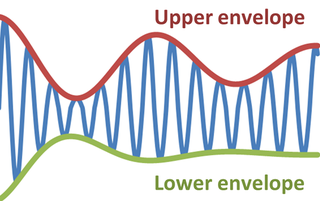
In physics and engineering, the envelope of an oscillating signal is a smooth curve outlining its extremes. The envelope thus generalizes the concept of a constant amplitude into an instantaneous amplitude. The figure illustrates a modulated sine wave varying between an upper envelope and a lower envelope. The envelope function may be a function of time, space, angle, or indeed of any variable.
The following timeline tables list the discoveries and inventions in the history of electrical and electronic engineering.
References
- ↑ Iain Logie Baird, The Last Remaining Scophony TV Receiver High Speed Scanner Motor
- ↑ The Setmakers by Keith Geddes and Gordon Bussey ( ISBN 0951704206)
- ↑ Paul Marshall, Inventing Television: Transnational Networks of Co-operation and Rivalry, 1870-1936
- ↑ Iain Logie Baird, Terry-Thomas and the Baird Portable , Bairdtelevision.com
- Waltz Jr., George (July 1948). "Theater Vision". Popular Science. pp. 109–113.
- Yanczer, Peter. "The Scophony System". Television Experimenters. Archived from the original (Web page) on 16 July 2011. Retrieved 2009-04-02.